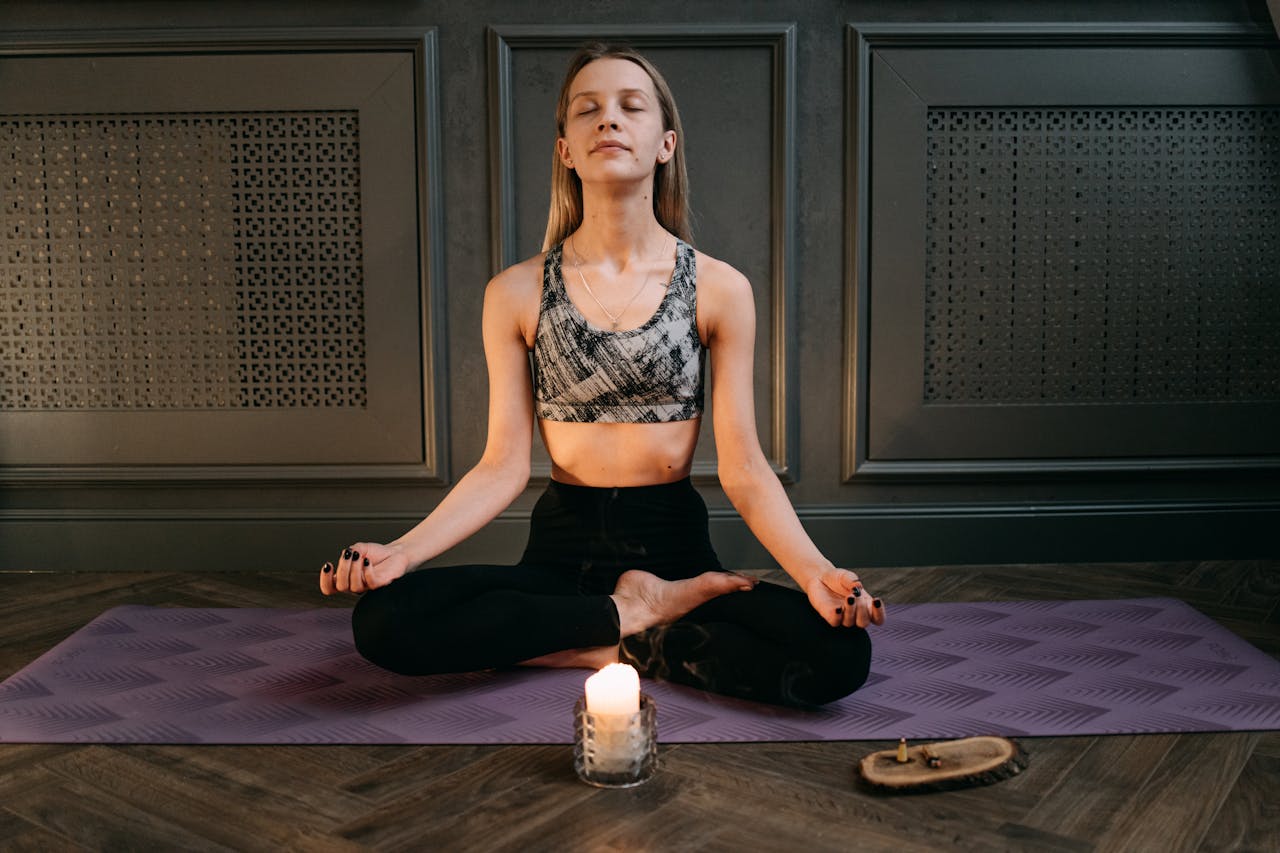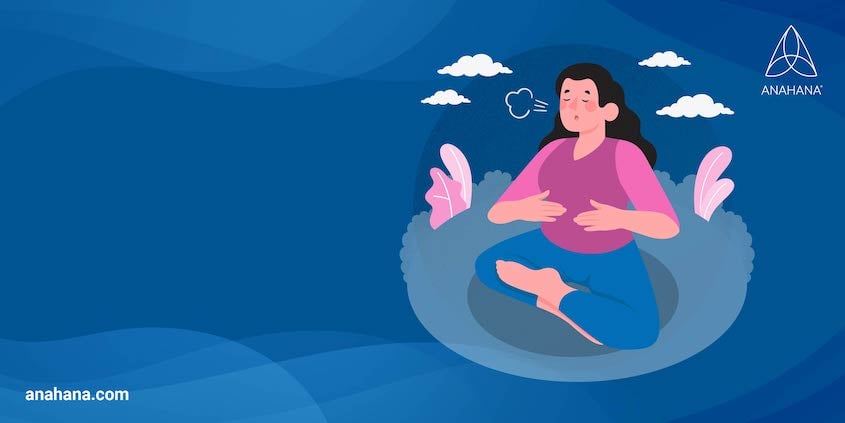
Pranayama, a fundamental part of yoga practice. Harness the power of breathing to improve your well-being.
Pranayama Breathing Explained
Pranayama is a yoga practice that involves conscious control of the breath to promote physical and mental well-being.
It includes various yoga breathing exercises, such as alternate nostril breathing, each with benefits like stress reduction, improved cognition, and increased energy.
In the ancient Hindu language of Sanskrit, Prana means energy or life force (breathing), while yama means control or regulation, and ayama means extension. Thus, Prana and Yama (Pranayama) created the term breath control for the extension of life.
People have practiced Pranayama breathing techniques for thousands of years, as mentioned in the Atharva Veda, an Ancient Indian religious text from 1000-900 BCE.
Over the last three millennia, practitioners of these breathing techniques have been reaping many profound benefits.
Today, yoga classes include yogic breathing as a part of the practice, but people may also practice Pranayama independently.
Benefits of Pranayama
Pranayama benefits range from better sleep and less muscle tension to a clearer and more focused mind. Some mental and physical benefits of consistent Pranayama practice include:
- Improved sleep
- Better focus and concentration
- Healthier cardiovascular health
- Improved respiration
- Better digestion and more regulated metabolism
- Enhanced cognitive performance
- Reduced anxiety and stress
- Improved mood stabilization
- Lowered high blood pressure
- Stronger immune system
- Abundance of vital energy
However, it should be noted that if Pranayama is improperly practiced, issues can arise without warning signals, so mindfulness and care are required.
The yogis describe Pranayama as accentuating whatever is in the mind, positive or negative. So, mental quirks or nervous tics could be exaggerated by wrong effort or excessive practice.
That being said, the benefits of Pranayama breathing are vast, and with steady and consistent practice, they’re highly attainable.
Regular Pranayama practice, with the support of a teacher, empowers you to experience improved mental clarity and physical health, fostering a sense of inner balance and holistic well-being.
How Does Pranyama Work?
Connecting the Mind and Body
When individuals harness the power of their breath through yoga breathing, they establish a strong connection between the body and mind.
Pranayama is an integral part of the mind-body connection emphasized in yogic traditions. The focus on breath awareness and control can enhance mindfulness and concentration, fostering a greater connection between the mind and body.
Improving Physiological Processes
Pranayama involves conscious breath control, influencing respiratory patterns and lung function. Slow, deep breathing can improve respiratory efficiency, increase lung capacity, and enhance blood oxygenation.
These changes may positively affect cardiovascular function, influencing heart rate, heart rate variability (HRV) , and blood pressure.
Altering Brain Activity
Some studies also suggest that Pranayama practices can influence brain wave patterns. For example, research has shown that slow and deep breathing can increase alpha brain wave activity, associated with a relaxed and alert mental state.
Changes in brain wave patterns may be indicative of altered states of consciousness and cognitive function.
Pranayama practices may also influence neurotransmitter levels in the brain. For example, changes in gamma-aminobutyric acid (GABA) levels, a neurotransmitter associated with relaxation, have been observed after Pranayama practice.
Activating the Vagus Nerve
Pranayama focuses on achieving and sustaining a consistent breathing rhythm during asana practice (Sanskrit term for yoga physical postures), which involves deep breathing exercises activating the vagus nerve. The vagus nerve is a long nerve that runs from the brainstem to the colon.
It controls the relaxation response and switches off our reflex for fight or flight, which often comes with stress.
Chronic stress is associated with elevated cortisol levels. Pranayama practices have been linked to reduced cortisol levels, indicating a potential stress-reducing effect.
This may be related to the impact of breath control on the hypothalamic-pituitary-adrenal (HPA) axis, which plays a central role in the body's stress response.
In short, activating the vagus nerve through Pranayama has a calming effect on the body and the mind. It also increases resilience and helps the body cope with elevated stress by bringing the body back down to a calm and relaxed state.
Pranayama Breathing Techniques
While some yogic breathing techniques may take longer to learn and be more advanced, beginners can start with a simple Pranayama technique to add to their daily routine.
There are several different variants of Pranayama breathing techniques, such as:
- Bhastrika (Bellows Breath)
- Kapalabhati
- Ujjayi breathing
- Bhramari Pranayama
- Dirga Pranayama
- Simhasana Pranayama
- Alternate nostril breathing
These fast and slow Pranayama practices focus on simple breath control, energy balance, and relaxation, making them accessible for those new to Pranayama. Here are some examples of the techniques:
Ujjayi

Ujjayi breathing is also called "ocean breath" or "victorious breath." Ujjayi is called “ocean breath” because this breathing technique creates a whispering sound similar to ocean waves.
Ujjayi Pranayama enhances mental clarity, concentration, and the flow of prana (energy) in the body, ultimately fostering relaxation and stress reduction.
Dirga or Three-Part Breath
Dirga Pranayama, also referred to as the Three-Part Breath or Complete Breath, is a Pranayama breathing technique that enables individuals to take fuller and deeper breaths by consciously engaging three parts of their torso: the abdomen, the diaphragm and ribcage, and the chest.
Simhasana or Lion's Breath
Simhasana, or Lion's Breath, is a yoga pose and breathing exercise that involves kneeling, opening the mouth wide, sticking out the tongue, and exhaling forcefully with a roaring sound.
This practice often releases tension, reduces stress, and promotes self-expression. The powerful breathing of Simhasana (Lion’s Breath) can help release inhibitions.
Kapalabhati or Skull Shining Breath
Kapalabhati, also known as Skull Shining Breath, is a Pranayama technique where one forcefully exhales through the nostrils while using quick, sharp contractions of the lower abdominal muscles followed by a passive inhalation.
Kapalabhati helps to cleanse the respiratory system, clear nasal passages, and increase lung capacity.
"Skull Shining Breath" refers to its revitalizing effect on the mind. It is known to:
- Stimulate blood flow to the brain
- Enhance mental clarity and alertness
- Boost energy
- Relieve stress
Bhastrika
Bhastrika involves forceful and rhythmic inhalation and exhalation through the nose, rapidly filling and emptying the lungs. This technique helps to increase oxygen intake, boost circulation, and energize the body.
This technique is also known to:
- Increase lung capacity
- Cleanse the respiratory system
- Enhance mental focus
- Reduce stress
- Balance the nervous system
Alternate Nostril Breathing
Alternate Nostril Breathing, or Nadi Shodhana, is a calming breathing technique.
It involves inhaling and exhaling through one nostril at a time while blocking the other.
This practice balances the left and right sides of the brain, promoting a sense of equilibrium, mental clarity and emotional stability.
Alternate Nostril Breathing is a valuable tool for relaxation and overall well-being. It is known to:
- Enhances lung function
- Reduces stress
- Calms the nervous system
- Improve focus and sleep quality
Progress in Practicing Pranayama
It’s advisable to practice Pranayama daily at the same time and place. This builds positive, spiritual vibrations in the space, and the regularity creates inner strength and willpower.
You should follow the general guidelines for Pranayama and the instructions from a teacher but also allow intuition and common sense to guide you.
If you’re on an advanced level, you should practice breath retention along with the three bandhas: Jalandhara Bandha (chin lock), Uddiyana Bandha (abdominal lock), and Moola Bandha (perineal lock). Practice Jalandhara and Moola bandha when you retain the breath inside.
All three bandhas are practiced when the breath is held outside (known as Mahabandha). The practice of bandhas with Pranayama builds up a negative pressure, redirecting the prana generated to the upper body and head, creating an intensity not experienced otherwise.
Difference Between Meditation and Pranayama
Both meditation and Pranayama are practices that decrease stress, encourage relaxation, and improve concentration. However, the two techniques differ slightly.
Meditation is a practice meant to train the mind in awareness and attention. One of the primary goals of meditation is to enhance mental clarity and reduce the continuous stream of thoughts and emotions in the mind. This mental clarity is achieved by disconnecting from thinking and focusing on objective observation.
Pranayama exercises, on the other hand, focus on breathing. It is the practice of harnessing the breath to deliver energy and calmness to the body and, in turn, clarity to the mind.
Both can also be practiced during and alongside yoga, and it’s possible to set an intention before a Pranayama practice, just as one would do before meditation.
Frequently Asked Questions
What is an example of a slow Pranayama practice?
Among common Pranayama techniques, "Brahmari Pranayama" is often considered one of the slowest.
In Brahmari Pranayama, you produce a gentle, humming sound while exhaling, which naturally slows down the breath and promotes deep relaxation.
It involves inhaling slowly and deeply through the nostrils and then exhaling even more slowly while making the humming sound like a bee.
This slow and deliberate exhalation, combined with the humming, can induce a profound sense of calm and tranquillity.
Out of all yogic breathing exercises, which one is more suitable for beginners?
For beginners, one of the most suitable yogic breathing exercises, or Pranayama techniques, is "Diaphragmatic Breathing" or "Deep Abdominal Breathing."
This fundamental and gentle practice helps individuals establish a strong foundation for more advanced Pranayama techniques.
Diaphragmatic breathing focuses on using the diaphragm (a muscle beneath the lungs) to take deep breaths instead of shallow chest breathing.
References
Pranayama for Beginners: Learn About the Practice + How to Start
Pranayamas and Their Neurophysiological Effects - PMC
Health Impacts of Yoga and Pranayama: A State-of-the-Art Review - PMC
Pranayama | Breathing Techniques, Meditation, Relaxation | Britannica
Disclaimer
The contents of this article are provided for informational purposes only and are not intended to substitute for professional medical advice, diagnosis, or treatment. It is always recommended to consult with a qualified healthcare provider before making any health-related changes or if you have any questions or concerns about your health. Anahana is not liable for any errors, omissions, or consequences that may occur from using the information provided.

By: Meriah McCauley
Meriah McCauley is passionate about the art and science of holistic health and healing. She explored the power of yoga through working with her mentor and guru Dr. Don Stapleton in Costa Rica. She also received a Masters in Psychology from Columbia University, specializing in Spirituality and the MindBody connection. Meriah now offers coaching, yoga teacher trainings, and Holotropic Breathwork for personal development. She loves to connect with those on this path.
